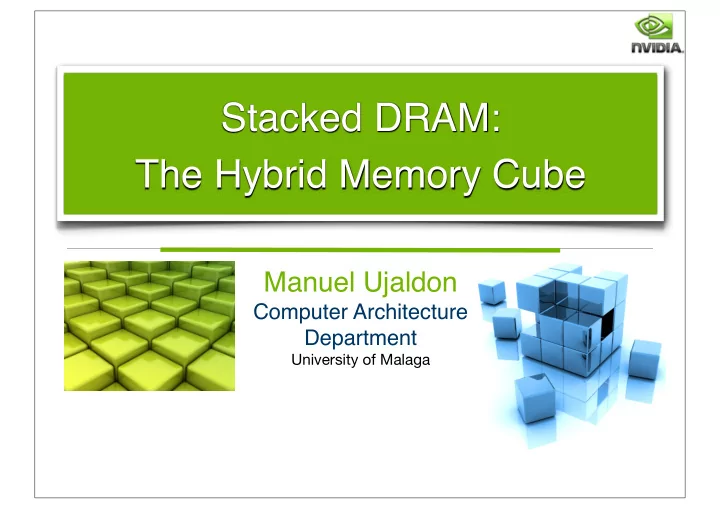

Stacked DRAM: The Hybrid Memory Cube Manuel Ujaldon Computer Architecture Department University of Malaga
A look ahead through Nvidia's GPU roadmap 2
A 2013 graphics card: Kepler GPU with GDDR5 video memory 3
A 2017 graphics card: Volta GPU with Stacked DRAM 4
A promising Stacked DRAM development: The Hybrid Memory Cube Consortium (HMCC) HMCC achievements and milestones Date First papers published about Stacked DRAM 2005, 2006 (based of research projects) First commercial announcement of the technology February, 2011 HMC Consortium is launched by Micron October, 2011 Technologies and Samsung Electronics Stacked DRAM announced for Volta GPU by Nvidia March, 2013 Specification 1.0 available April, 2013 Production samples Second half of 2014 (estimated) 2.5 configuration available End of 2014 (estimated) 5
Developer members of HMCC (as of May'13) Founders of the consortium 6
Broader adoption HMC was primarily oriented to HPC and networking, but it can also be useful for mobile and DDR-like technol. HMC is tightly coupled with CPUs, GPUs and ASICS in point-to-point configurations, where HMC performance is available for optical memory bandwidth. 7
The Hybrid Memory Cube at a glance Revolutionary Approach to Break Through the “Memory Wall” ► Evolutionary DRAM roadmaps hit limitations of bandwidth and power efficiency ► Micron introduces a new class of memory: Hybrid Memory Cube ► Unique combination of DRAMs on Logic HMC Key Features Unparalleled performance ► Up to 15X the bandwidth of a DDR3 ► Micron-designed logic controller module ► High speed link to CPU ► 70% less energy usage per bit than ► Massively parallel “Through Silicon existing technologies Via” connection to DRAM ► Occupying nearly 90% less space than today’s RDIMMs Full silicon prototypes in silicon TODAY Targeting high performance computing and networking, eventually migrating into computing and consumer 8
Architectural highlights Stacked DRAM is an abstracted memory management layer. The traditional DRAM core cell architecture is restructured to use memory vaults rather than arrays. A logic controller is placed at the base of the DRAM stack. The assembly is interconnected with through-silicon vias (TSVs) that go up and down the stack. The final step is advanced package assembly. 9
Architectural details 1. DRAM is partitioned into 16 parts like DDR3 and DDR4. 2. Common logic is extracted from all partitions. 3. DRAM is piled up in 4-high or 8-high configurations. 4. Common logic is re-inserted at the logic base die. 5. 16 vaults are built. Each consists of either 4 or 8 parts of each layer plus logic underneath, and can be thought of as individual channels in the regular architecture. 6. A high speed link connects DRAM and processor, with: 1. Advanced switching. 2. Optimized memory control. 3. Simple interface. 4. 16 transmits and receive lanes, each running at 10 GB/s. 10
HMC Architecture Logic Base Vault Control Vault Control Vault Control Vault Control Memory Control Add advanced switching, optimized memory control and simple interface to host processor(s)… Crossbar Switch Link Interface Link Interface Link Interface Link Interface Controller Controller Controller Controller 3DI & TSV Processor Technology DRAM7 DRAM6 Links DRAM5 DRAM4 DRAM3 DRAM2 DRAM1 DRAM0 Logic Chip Vault DRAM Logic Base 11
HMC supports stacked DRAM in two different flavours: Near memory and far memory Near memory: Far memory: 12
HMC near memory All links between CPU and HMC logic layer. Maximum bandwidth per GB. capacity. Target systems: HPC and servers. Hybrid CPU/GPU platforms. Graphics. Networking. Test equipment. 13
HMC far memory • Far memory ▶ Some HMC links connect to host, some to other cubes. ▶ Scalable to meet system requirements. ▶ Can be in module form or soldered-down. • Future interfaces may include ▶ Higher speed electrical (SERDES) ▶ Optical ▶ Whatever the best interface for the job! 14
A comparison in bandwidth with existing technologies On a CPU system (PC with a dual channel motherboard): [2013] DDR3 @ 4 GHz (2x 2000 MHz): 64 Gbytes/s. [2014] HMC 1.0 (first generation): 640 Gbytes/s. [2015] HMC 2.0 (second generation): 898 Gbytes/s . A 2x improvement can be reached in a quad-channel motherboard. On a GPU system (384-bits wide graphics card): GDDR5 @ 7 GHz: 336 Gbytes/s. 12 chips 32-bits wide are soldered to the printed circuit board, where HMC 2.0 chips achieve 2688 Gbytes/s (2.62 Tbytes/s). 15
Additional information available on the Web The Hybrid Memory Cube Consortium: http://www.hybridmemorycube.org (specification 1.0 available as PDF). CUDA Education (presentations, exercises, tools, utilities): http://developer.nvidia.com/cuda-education Keynotes and technical sessions from GTC'13: http://www.gputechconf.com/gtcnew/on-demand-gtc.php You will find more than 300 talks. Particularly recommended: "Future directions for CUDA" by Mark Harris. "Multi-GPU Programming" by Levi Barnes. "Performance Optimization Programming Guidelines..." by Paulius Micikevicius. "Performance Optimization Strategies for GPU-accel. Applications" by David Goodwin. "Languages, Libraries and Development Tools for GPU Computing" by Will Ramey. "Getting Started with OpenACC" by Jeff Larkin. "Optimizing OpenACC Codes" by Peter Messmer. 16
Acknowledgements To the great Nvidia people, for sharing with me ideas, material, figures, presentations, ... In alphabetical order: Bill Dally [2010-2011: Power consumption, Echelon and future designs]. Simon Green [2007-2009: CUDA pillars]. Sumit Gupta [2008-2009: Tesla hardware]. Mark Harris [2008, 2012: CUDA, OpenACC, Programming Languages, Libraries]. Wen-Mei Hwu [2009: Programming and performance tricks]. Stephen Jones [2012: Kepler]. David B. Kirk [2008-2009: Nvidia hardware]. David Luebke [2007-2008: Nvidia hardware]. Lars Nyland [2012: Kepler]. Edmondo Orlotti [2012: CUDA 5.0, OpenACC]. ... just to name a few of those who contributed to my presentations. Also thanks to Scott Stevens and Susan Platt from Micron 17
Thanks for attending! You can always reach me in Spain at the Computer Architecture Department of the University of Malaga: e-mail: ujaldon@uma.es Phone: +34 952 13 28 24. Web page: http://manuel.ujaldon.es (english/spanish versions available). 18
Recommend
More recommend